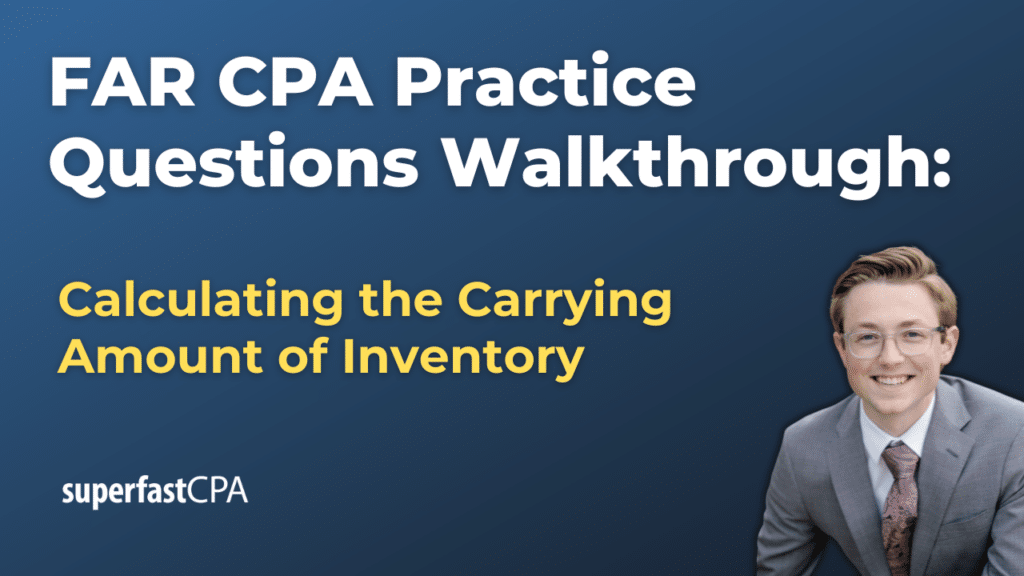In this video, we walk through 5 FAR practice questions teaching about calculating the carrying amount of inventory. These questions are from FAR content area 2 on the AICPA CPA exam blueprints: Select Balance Sheet Accounts.
The best way to use this video is to pause each time we get to a new question in the video, and then make your own attempt at the question before watching us go through it.
Also be sure to watch one of our free webinars on the 6 “key ingredients” to an extremely effective & efficient CPA study process here…
Calculating the Carrying Amount of Inventory
Calculating the carrying amount of inventory involves determining the value of inventory on hand at the end of an accounting period, using specific costing methods. Each method impacts the ending inventory and Cost of Goods Sold (COGS) differently, depending on how inventory flows are tracked. Below is an overview of the main inventory costing methods, along with an explanation of how each impacts the carrying amount and examples to illustrate these concepts.
1. FIFO (First-In, First-Out)
- FIFO assumes that the oldest inventory items are sold first, so the remaining inventory consists of the most recently purchased items. This method is commonly used when inventory is not perishable, and it reflects a natural flow of goods.
Impact on Inventory Valuation:
- Ending inventory is valued using the most recent purchase costs, while COGS is based on older, lower costs (assuming prices are rising). This results in higher ending inventory values and lower COGS in times of rising prices.
Example:
- Beginning Inventory: 1,000 units @ $10 = $10,000
- Purchases:
- 500 units @ $12 = $6,000
- 600 units @ $15 = $9,000
- Sale of 1,200 units:
- COGS = 1,000 units @ $10 + 200 units @ $12 = $10,000 + $2,400 = $12,400
- Ending Inventory = 300 units @ $12 + 600 units @ $15 = $3,600 + $9,000 = $12,600
Journal Entry for Sale:
- Debit: Cost of Goods Sold $12,400
- Credit: Inventory $12,400
2. Perpetual LIFO (Last-In, First-Out)
- Perpetual LIFO updates the inventory balance and COGS continuously after each purchase and sale transaction. It assumes that the most recently purchased items are sold first at the time of each sale.
Impact on Inventory Valuation:
- The COGS is determined using the most recent purchase prices before each sale, and the ending inventory is valued using older costs. This can lead to lower ending inventory values and higher COGS when prices are rising.
Example:
- Beginning Inventory: 1,000 units @ $10 = $10,000
- Purchases:
- 500 units @ $12
- Sale of 800 units:
- Sold using 500 units @ $12 + 300 units @ $10
- COGS = $6,000 + $3,000 = $9,000
- Ending Inventory: 700 units @ $10 = $7,000
Journal Entry for Sale:
- Debit: Cost of Goods Sold $9,000
- Credit: Inventory $9,000
3. Periodic LIFO (Last-In, First-Out)
- Periodic LIFO calculates inventory values and COGS at the end of the period, using the most recent purchase costs for all units sold during the period. It assumes the most recent purchases are sold first for the entire period.
Impact on Inventory Valuation:
- The ending inventory consists of the oldest costs, and COGS is based on newer costs. This results in higher COGS and lower ending inventory values in times of rising prices.
Example:
- Beginning Inventory: 1,000 units @ $10
- Purchases:
- 500 units @ $12
- 600 units @ $15
- Total Units Available = 2,100 units
- Sale of 1,400 units:
- COGS uses the most recent costs: 600 units @ $15 + 500 units @ $12 + 300 units @ $10
- COGS = $9,000 + $6,000 + $3,000 = $18,000
- Ending Inventory = 700 units @ $10 = $7,000
Journal Entry for Period-End Adjustments:
- Debit: Cost of Goods Sold $18,000
- Credit: Inventory $18,000
4. Dollar-Value LIFO
- Dollar-Value LIFO focuses on changes in the dollar value of inventory, rather than units, using a base-year value to track changes. It converts current inventory to base-year dollars using a price index, and any increases are valued as new layers using the current price index.
Impact on Inventory Valuation:
- This method separates changes in inventory due to price fluctuations from real quantity changes, allowing a more precise calculation of ending inventory. It results in new inventory layers being valued at current prices, while older layers remain at base-year prices.
Example:
- Year 1: Beginning Inventory = $100,000 (Base Year)
- Year 2: Ending Inventory at Current Prices = $135,000; Price Index = 1.08
- Base-Year Dollars = $135,000 / 1.08 = $125,000
- New Layer = $125,000 – $100,000 = $25,000
- New Layer Value = $25,000 * 1.08 = $27,000
- Year 2 Inventory Value = $100,000 + $27,000 = $127,000
Journal Entry for Adding a New Layer:
- Debit: Inventory $27,000
- Credit: Cost of Goods Sold $27,000
5. FOB Shipping Point and FOB Destination
- FOB Shipping Point: Ownership of inventory transfers to the buyer when goods are shipped, so inventory is included on the buyer’s books as soon as it leaves the seller’s location.
- FOB Destination: Ownership transfers when goods arrive at the buyer’s location, so inventory is recorded only when received by the buyer.
Impact on Inventory Valuation:
- FOB Shipping Point: Purchases are recorded as soon as they are shipped, even if they have not arrived yet.
- FOB Destination: Purchases are not recorded until the inventory physically arrives.
Example for FOB Shipping Point:
- A buyer purchases goods on December 28, shipped FOB Shipping Point. If the goods arrive on January 2, the buyer includes the goods in December’s ending inventory.
Example for FOB Destination:
- A buyer purchases goods on December 28, shipped FOB Destination. If the goods arrive on January 2, they are not included in December’s inventory.













